Sea serpent
A sea serpent or sea dragon is a type of dragon described in various mythologies,[1] most notably Greek (Cetus, Echidna, Hydra, Scylla), Mesopotamian (Tiamat), Hebrew (Leviathan), and Norse (Jörmungandr).
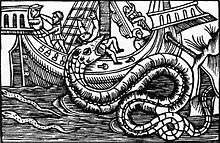 A sea serpent from Olaus Magnus's book History of the Northern Peoples (1555). | |
| Grouping | Legendary creature |
|---|---|
| Sub grouping | Sea monster |
| Other name(s) | Worm, wyrm, sea dragon |
| Region | Worldwide |
Mythology
| Part of a Mythology series on |
| Chaoskampf or Drachenkampf |
|---|
 |
| Comparative mythology of sea serpents, dragons and dragonslayers. |
|
Myths
|
|
The Drachenkampf mytheme, the chief god in the role of the hero slaying a sea serpent, is widespread both in the Ancient Near East and in Indo-European mythology, e.g. Lotan and Hadad, Leviathan and Yahweh, Tiamat and Marduk (see also Labbu, Bašmu, Mušḫuššu), Illuyanka and Tarhunt, Yammu and Baal in the Baal Cycle etc. The Hebrew Bible also has less mythological descriptions of large sea creatures as part of creation under God's command, such as the Tanninim mentioned in Book of Genesis 1:21 and the "great serpent" of Amos 9:3. In the Aeneid, a pair of sea serpents killed Laocoön and his sons when Laocoön argued against bringing the Trojan Horse into Troy.
In antiquity and in the Bible, dragons were envisioned as huge serpentine monsters, which means that the image of a dragon with two or four legs and wings came much later during the Late Middle Ages. Stories depicting sea-dwelling serpents may include the Babylonian myths of Tiamat, the myths of the Hydra, Scylla, Cetus and Echidna in the Greek mythology, and even the Leviathan.
In Norse mythology, Jörmungandr (or Midgarðsormr) was a sea serpent so long that it encircled the entire world, Midgard. Some stories report of sailors mistaking its back for a chain of islands. Sea serpents also appear frequently in later Scandinavian folklore, particularly in that of Norway.[2][3]
In 1028 AD, Saint Olaf is said to have killed a sea serpent in Valldal, Norway, throwing its body onto the mountain Syltefjellet. Marks on the mountain are associated with the legend.[4][5] In Swedish ecclesiastic and writer Olaus Magnus's Carta marina, many marine monsters of varied form, including an immense sea serpent, appear. In his 1555 work History of the Northern Peoples, Magnus gives the following description of a Norwegian sea serpent:
Those who sail up along the coast of Norway to trade or to fish, all tell the remarkable story of how a serpent of fearsome size, 200 feet [60 m] long and 20 feet [6 m] wide, resides in rifts and caves outside Bergen. On bright summer nights this serpent leaves the caves to eat calves, lambs and pigs, or it fares out to the sea and feeds on sea nettles, crabs and similar marine animals. It has ell-long hair hanging from its neck, sharp black scales and flaming red eyes. It attacks vessels, grabs and swallows people, as it lifts itself up like a column from the water.[6][7]
Possible sightings
An apparent eye-witness account is found in Aristotle's Historia Animalium. Strabo makes reference to an eyewitness account of a dead sea creature sighted by Poseidonius on the coast of the northern Levant. He reports the following: "As for the plains, the first, beginning at the sea, is called Macras, or Macra-Plain. Here, as reported by Poseidonius, was seen the fallen dragon, the corpse of which was about a plethrum [30 m or 100 feet] in length, and so bulky that horsemen standing by it on either side could not see one another; and its jaws were large enough to admit a man on horseback, and each flake of its horny scales exceeded an oblong shield in length."[8] The creature was seen by Poseidonius, a Philosopher, sometime between 130 and 51 BC.
Hans Egede, the national saint of Greenland, gives an 18th-century description of a sea serpent. On July 6, 1734 his ship sailed past the coast of Greenland when suddenly those on board "saw a most terrible creature, resembling nothing they saw before. The monster lifted its head so high that it seemed to be higher than the crow's nest on the mainmast. The head was small and the body short and wrinkled. The unknown creature was using giant fins which propelled it through the water. Later the sailors saw its tail as well. The monster was longer than our whole ship", wrote Egede.[9]
On 6 August 1848, Captain McQuhae of HMS Daedalus and several of his officers and crew (en route to St Helena) saw a sea serpent which was subsequently reported (and debated) in The Times. The vessel sighted what they named as an enormous serpent between the Cape of Good Hope and St Helena. The serpent was witnessed to have been swimming with 1.2 m (4 feet) of its head above the water and they believed that there was another 18 m (60 feet) of the creature in the sea. Captain McQuahoe also said that "[The creature] passed rapidly, but so close under our lee quarter, that had it been a man of my acquaintance I should have easily have recognised his features with the naked eye." According to seven members of the crew it remained in view for around twenty minutes. Another officer wrote that the creature was more of a lizard than a serpent. Evolutionary biologist Gary J. Galbreath contends that what the crew of Daedalus saw was a sei baleen whale.[10]
A report was published in the Illustrated London News on 14 April 1849 of a sighting of a sea serpent off the Portuguese Coast by the HMS Plumper.
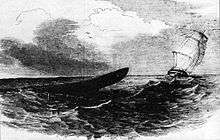
On the morning of the 31st December, 1848, in lat. 41° 13'N., and long. 12° 31'W., being nearly due west of Oporto, I saw a long black creature with a sharp head, moving slowly, I should think about two knots [3.7 km/h; 2.3 mph] ... its back was about twenty feet [6 m] if not more above water; and its head, as near as I could judge, from six to eight [1.8 to 2.4 m] ...There was something on its back that appeared like a mane, and, as it moved through the water, kept washing about; but before I could examine it more closely, it was too far astern
— "A Naval Officer"[11]
Gallery
 Olaus Magnus's Sea Orm, 1555
Olaus Magnus's Sea Orm, 1555 The first American sea serpent, reported from Cape Ann, Massachusetts, in 1639
The first American sea serpent, reported from Cape Ann, Massachusetts, in 1639 Sea serpents, Ama Temple, Macao
Sea serpents, Ama Temple, Macao A sea serpent depicted in the coat of arms of Seljord in Norway
A sea serpent depicted in the coat of arms of Seljord in Norway Sea serpent reported by Hans Egede, Bishop of Greenland, in 1734. Henry Lee suggested the giant squid as an explanation.
Sea serpent reported by Hans Egede, Bishop of Greenland, in 1734. Henry Lee suggested the giant squid as an explanation. The "Great Sea Serpent" according to Hans Egede
The "Great Sea Serpent" according to Hans Egede Maned sea serpent from Bishop Erik Pontoppidan's 1755 work Natural History of Norway
Maned sea serpent from Bishop Erik Pontoppidan's 1755 work Natural History of Norway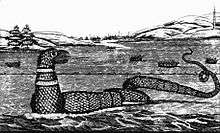 The Gloucester sea serpent of 1817
The Gloucester sea serpent of 1817 A hairy sea serpent
A hairy sea serpent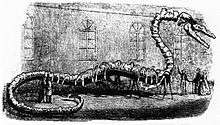 Albert Koch's 35-metre-long (115-foot) "Hydrarchos" fossil skeleton from 1845. It was found to be an assembled collection of bones from at least five fossil specimens of Basilosaurus.
Albert Koch's 35-metre-long (115-foot) "Hydrarchos" fossil skeleton from 1845. It was found to be an assembled collection of bones from at least five fossil specimens of Basilosaurus. "Supposed Appearance Of The Great Sea-Serpent, From H.M.S. Plumper, Sketched By An Officer On Board", Illustrated London News, 14 April 1849
"Supposed Appearance Of The Great Sea-Serpent, From H.M.S. Plumper, Sketched By An Officer On Board", Illustrated London News, 14 April 1849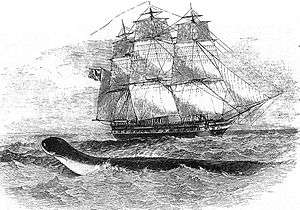 The sea serpent spotted by the crew of HMS Daedalus in 1848
The sea serpent spotted by the crew of HMS Daedalus in 1848 Another of the original illustrations of the HMS Daedalus encounter
Another of the original illustrations of the HMS Daedalus encounter Oarfish that washed ashore on a Bermuda beach in 1860. The animal was 5 m (16 feet) long and was originally described as a sea serpent.
Oarfish that washed ashore on a Bermuda beach in 1860. The animal was 5 m (16 feet) long and was originally described as a sea serpent.
See also
References
- "Sea serpent | mythology". Encyclopedia Britannica. Retrieved March 31, 2020.
- "Sea Serpent?". Ask.com. Archived from the original on October 25, 2013. Retrieved August 21, 2012.
- "The Unexplained Mystery of the Sea Serpent". Crypted Chronicles. March 18, 2012. Retrieved August 21, 2013.
- "Ormen i Syltefjellet". Archived from the original on July 24, 2011.
- "Galleri NOR". Nb.no. July 11, 1934. Retrieved July 10, 2014.
- "Norse Mythology – Jormungandr". Oracle Thinkquest. Archived from the original on August 21, 2013. Retrieved August 21, 2013.
- Stewart, Gail Barbara (2011). Water Monsters. San Diego, California: ReferencePoint Press. p. 13. ISBN 978-1-60152-345-7.
- Strabo. Geography. Book 16, chapter 2, paragraph 17.
- Mareš, Jaroslav (1997). Svět tajemných zvířat [The World of Mysterious Animals] (in Czech). Prague: Littera Bohemica. ISBN 80-85916-16-9.
- "The Daedalus Sea Serpent Solved". Skeptical Inquirer. September–October 2015. Retrieved June 21, 2020.CS1 maint: date format (link)
- "Supposed Appearance of the Great Sea Serpent From HMS Plumper Sketched by an Officer On Board". Illustrated London News. April 14, 1849.
Further reading
- Lyons, Sherrie Lynne (2010). Species, Serpents, Spirits, and Skulls: Science at the Margins in the Victorian Age. State University of New York Press. ISBN 978-1-4384-2802-4.
External links
| Wikimedia Commons has media related to Sea serpent. |
- Video of the oarfish, a creature that inspired the sea serpent mythology.